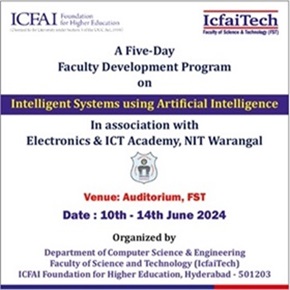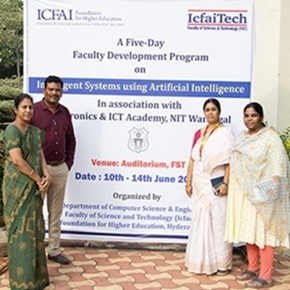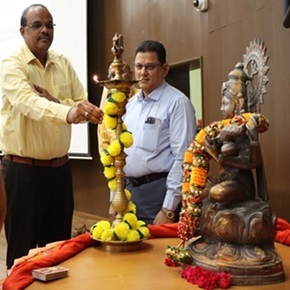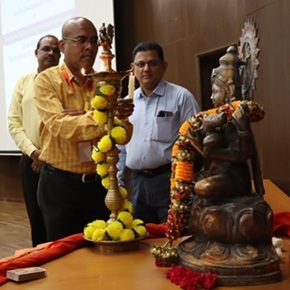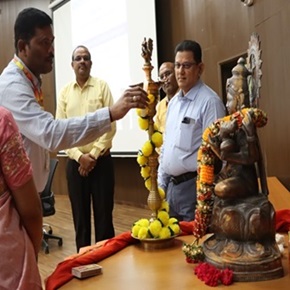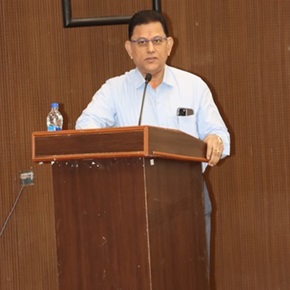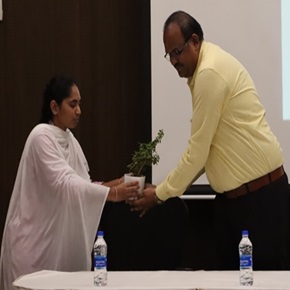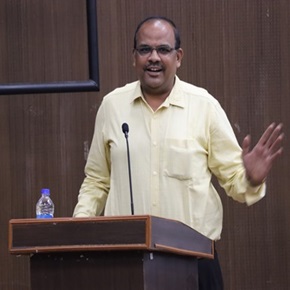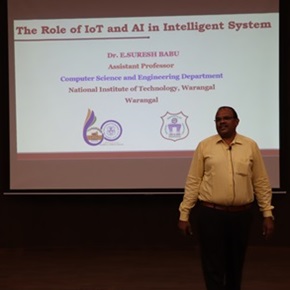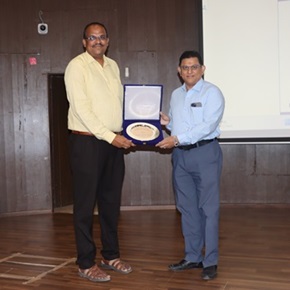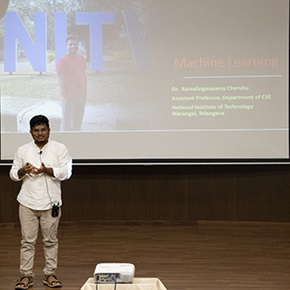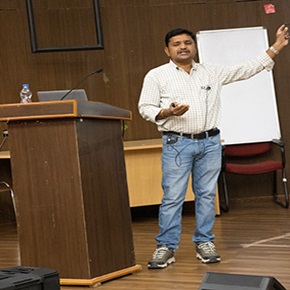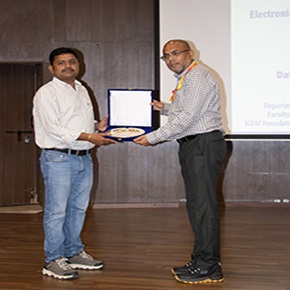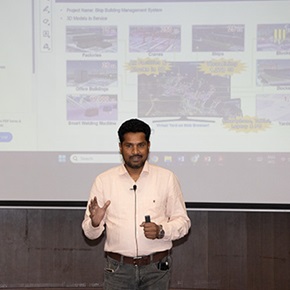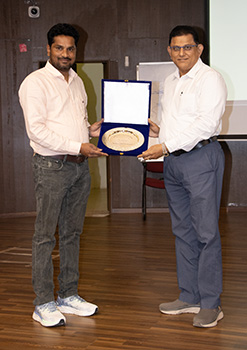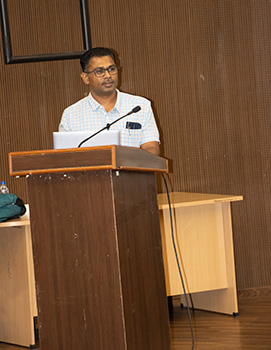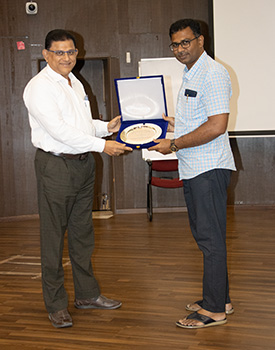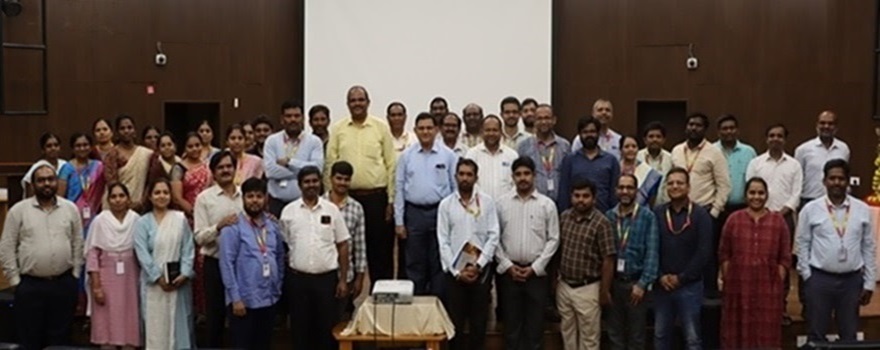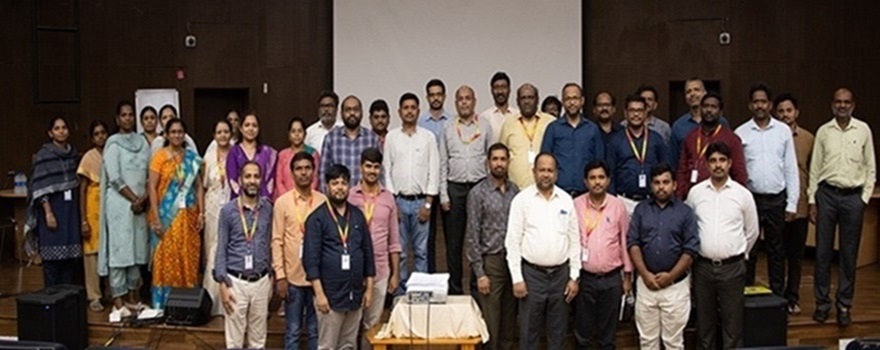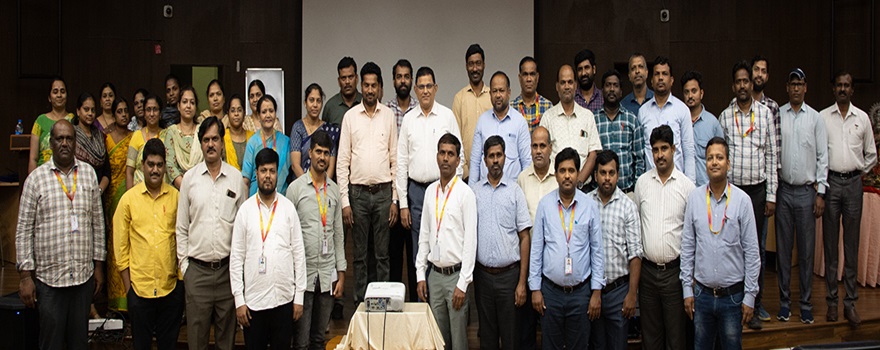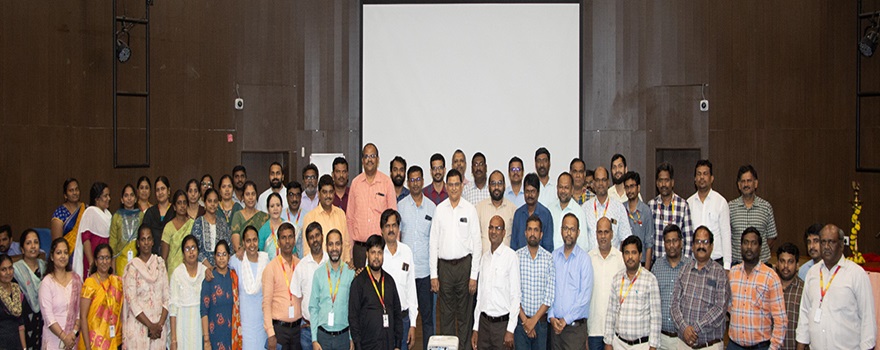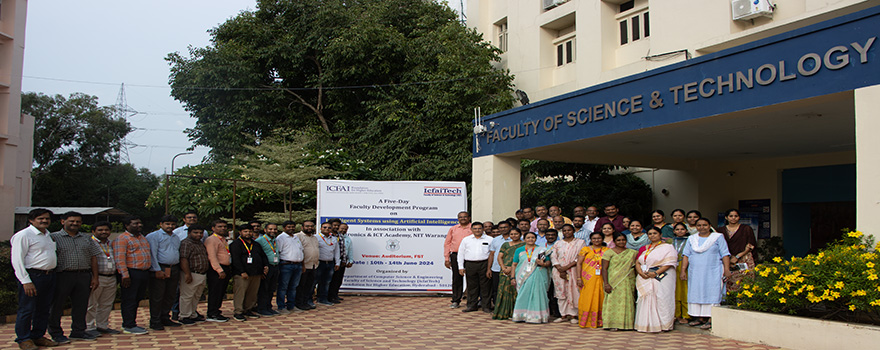Preface
Five Day Faculty Development Program on Intelligent Systems Using Artificial Intelligence, in Association with Electronics & ICT Academy National Institute of Technology Warangal.
The Faculty Development Program, designed to empower educators with the latest pedagogical strategies and technological advancements. This initiative aims to enhance teaching efficacy, foster innovative practices, and promote a collaborative learning environment. Through a series of interactive Presentations, expert-led seminars, and hands-on training sessions on cutting-edge topics such as Block Chain Technology, AI using IoT, machine learning algorithms, Autonomous Vehicles and Video analytics, participants gained valuable insights and skills to elevate their teaching methodologies. It explored the integration of AI-driven tools, adaptive learning platforms, and intelligent tutoring systems to personalize and optimize the educational experience.
This event is meticulously organized by Department of computer Science, IFHE Hyderabad, a leader in educational innovation, committed to fostering continuous professional development. Our organization plays a pivotal role in curating a comprehensive curriculum, inviting esteemed experts from academia and industry, and providing state-of-the-art resources to ensure a rich and impactful learning experience. We are excited to embark on this journey of professional growth together, dedicated to enriching the academic experience for both educators and students alike.
The Faculty Development Program was inaugurated on 10th May 2024 by the Director ICFAITech Prof. K.L. Narayana sir. The Deans, Associate Deans, Heads of all the departments, Faculty members, and Research Scholars were present for this event.
Inaugural Session
Dr P Priyanka faculty of DSAI program has begun the program by greeting and calling the delegates on to the stage. She started the session with few words as-"Good morning everyone. We are delighted to welcome you all to the inaugural function of our Faculty Development Program. This program aims to enhance the skills and knowledge of our esteemed faculty members, and we are excited to embark on this journey of learning and growth together."
With this, the event started by inviting the Director-FST Dr K L Narayan, Guest ,Dr. E. Suresh Babu –NITW, Professor-in-charge –Dr Sandeep Panda and Heads of both the department (Dr P Rohini & Dr P Pavan Kumar) on to the stage.
Director, Dr K L Narayana addressed the gathering. He started with the words – “It is with great pleasure that I welcome you to the Faculty Development Program. As educators, we play a crucial role in shaping the future, and it is imperative that we continuously evolve and adapt to the ever-changing landscape of education. This program is designed to equip you with the latest advancements in technological strategies and Research Development, particularly in the realm of artificial intelligence and data-driven education.
Our organization, IFHE, is deeply committed to support faculty professional growth. We have curated a series of workshops, seminars, and training sessions led by esteemed experts in the field. These sessions will cover cutting-edge topics such as Block chain, IoT, Security Autonomous systems, machine learning algorithms and the integration of AI-driven tools in the classroom”.
He said- “I encourage you to take full advantage of the resources and expertise available throughout this program. Engage actively, share your experiences, and collaborate with your peers. Together, we can foster an innovative and dynamic learning environment that not only enhances our teaching methodologies but also significantly benefits our students.
Let us embark on this journey of professional development with enthusiasm and a commitment to continuous improvement.
Welcome once again, and I look forward to a productive and inspiring program”.
There were remarks given by the speaker on conducting the event offline. His words went on something like – “It is an honor and a privilege to be here today as a guest speaker for this esteemed Faculty Development Program. I am excited to engage with such a distinguished group of educators who are dedicated to advancing their professional skills and enhancing the educational experience for their students.
In today's rapidly evolving world, the role of educators has become more dynamic and multifaceted than ever before. In the landscape of education, continuous learning and professional development are more critical than ever. As educators, we must stay abreast of the latest pedagogical strategies, technological advancements, and industry trends to provide our students with the best possible education.
I encourage all of you to actively engage in the workshops, seminars, and hands-on sessions that have been meticulously planned. Share your experiences, collaborate with your peers, and explore how these emerging technologies can be integrated into your teaching practices.
In closing, I want to emphasize that our journey of professional development is a continuous one. By embracing new technologies and innovative teaching methodologies, we can better prepare our students for the challenges of the future. Let us make the most of this opportunity to learn, grow, and inspire each other.
Thank you once again for having me here. I look forward to an enriching and productive program ahead.”
Dr. P Rohini Welcomed the guest and Director sir, she informed the faculty about attending the five days FDP program.
Dr. P Pavan Kumar HoD of DSAI Program threw highlight on FDP programs conducted by E&ICT and asked the faculty to be a part of this event.
The inaugural session ended with a high tea.
Day 1
Dr E Suresh Babu, Asst.Professor in CSE Department from NIT Warangal, started his session by giving introduction to IoT, Role of IoT in security using Block chain.
Session highlights were:
1. Enhanced Security and Privacy
- Decentralized Security: By integrating block chain technology, IoT devices can benefit from a decentralized security model, reducing the risk of a single point of failure and making it harder for attackers to compromise the network.
- Immutable Records: Block chain ensures that all transactions and data exchanges between IoT devices are recorded in an immutable ledger, enhancing data integrity and trust.
- Secure Authentication: Block chain can provide robust authentication mechanisms for IoT devices, ensuring that only authorized devices can participate in the network.
2. Efficient Data Processing and Reduced Latency
- Edge Computing: By processing data closer to the source (i.e., at the edge of the network), edge computing reduces latency and bandwidth usage, enabling real-time data analysis and decision-making.
- Fog Computing: Fog computing extends cloud capabilities to the edge of the network, providing additional processing power and storage closer to IoT devices. This hybrid approach helps manage the vast amount of data generated by IoT devices efficiently.
3. Improved Scalability and Flexibility
- Scalable Solutions: Edge and fog computing provide scalable solutions for managing IoT networks, as they can handle large volumes of data and devices without overwhelming the central cloud infrastructure.
- Flexible Deployment: These technologies allow for flexible deployment models, enabling the distribution of computing resources as needed to optimize performance and security.
4. Enhanced Data Privacy
- Local Data Processing: By processing sensitive data locally on edge devices or within the fog layer, the exposure of data to external threats is minimized, enhancing privacy.
- Selective Data Sharing: Block chain can facilitate selective data sharing, allowing IoT devices to share only the necessary data with authorized entities, thus protecting sensitive information.
5. Improved Resilience and Reliability
- Fault Tolerance: The distributed nature of block chain, coupled with edge and fog computing, enhances the resilience of the IoT network by ensuring that data and services are available even if some nodes fail.
- Continuous Operation: Edge and fog nodes can operate independently from the central cloud, ensuring continuous operation of critical IoT services even during network outages.
6. Streamlined Device Management and Updates
- Smart Contracts: Block chain-enabled smart contracts can automate and enforce policies for IoT device management, ensuring timely software updates and compliance with security protocols.
- Efficient Upgrades: Edge and fog computing facilitate efficient distribution of firmware and software updates across IoT devices, reducing downtime and ensuring devices are always up-to-date with the latest security patches.
7. Use Cases
- Smart Cities: Enhanced security for IoT devices in smart city infrastructure, including traffic management, surveillance, and public services.
- Industrial IoT (IIoT): Secure and efficient management of industrial devices and sensors, ensuring reliable operation and data integrity in manufacturing and logistics.
- Healthcare: Secure transmission and processing of sensitive patient data from medical IoT devices, ensuring compliance with privacy regulations and improving patient care.
By leveraging block chain, edge, and fog computing, IoT networks can achieve higher security, improved efficiency, and greater flexibility, addressing many of the current challenges in IoT security and management.
Day 2
Dr P Priyanka invited the guest for second day with the words – “hope you all had a restful evening and are energized for another day of learning and exploration at our Faculty Development Program. Yesterday, we delved into Block chain, IOT and how Block chain implements security using IOT concepts. Today, we are excited to build upon that foundation and dive deeper into Machine Learning algorithms for intelligent systems”.
The Speaker Dr Cheruku Ramalingaswamy introduced himself as well as the session topics. The key highlights were
1. Definition
- Deep Learning (DL) is a subset of machine learning that involves neural networks with many layers (deep neural networks) capable of learning from large amounts of data.
2. Neural Networks:
- Artificial Neural Networks (ANNs): Composed of layers of interconnected nodes (neurons) that mimic the human brain’s neural structure. Each connection has a weight that is adjusted during training.
- Activation Functions: Functions such as ReLU, sigmoid, and tanh that introduce non-linearity into the network, enabling it to learn complex patterns.
3. Types of Neural Networks:
- Feedforward Neural Networks (FNN): Information moves in one direction, from input to output.
- Convolutional Neural Networks (CNNs): Specialized for processing grid-like data such as images, using convolutional layers to automatically detect features.
- Recurrent Neural Networks (RNNs): Designed for sequential data, with connections forming cycles to maintain information over time. Variants include Long Short-Term Memory (LSTM) and Gated Recurrent Units (GRUs).
- Generative Adversarial Networks (GANs): Composed of two networks (generator and discriminator) that compete against each other to produce realistic data samples.
4. Training Deep Learning Models:
- Backpropagation: The algorithm used for training neural networks, involving the calculation of gradients and updating weights to minimize the loss function.
- Optimization Algorithms: Methods such as Stochastic Gradient Descent (SGD), Adam, and RMSprop used to update the model’s weights during training.
5. Applications:
- Computer Vision: Image classification, object detection, and facial recognition.
- Natural Language Processing (NLP): Language translation, sentiment analysis, and speech recognition.
- Healthcare: Medical image analysis, drug discovery, and personalized medicine.
- Autonomous Vehicles: Sensor data processing and decision-making for self-driving cars.
6. Challenges and Considerations:
- Overfitting and Under fitting: Overfitting occurs when a model learns noise in the training data, while under fitting happens when a model is too simple to capture the underlying pattern.
- Data Requirements: Deep learning models typically require large amounts of data for effective training.
- Computational Resources: Training deep learning models can be resource-intensive, often requiring powerful GPUs or TPUs.
By understanding these key concepts, educators and practitioners can better leverage machine learning and deep learning techniques in various applications and research areas.
Linear Regression
1. Model Representation:
- Equation: y=Xβ+ϵy = X\beta + \epsilony=Xβ+ϵ, where yyy is the target, XXX is the input matrix, β\betaβ are the coefficients, and ϵ\epsilonϵ is the error term.
2. Cost Function:
- Mean Squared Error (MSE): MSE=1n∑i=1n(yi−y^i)2\text{MSE} = \frac{1}{n} \sum_{i=1}^{n} (y_i - \hat{y}_i)^2MSE=n1∑i=1n(yi−y^i)2, used to measure the accuracy of the linear regression model.
3. Gradient Descent:
- Update Rule: β=β−α∇J(β)\beta = \beta - \alpha \nabla J(\beta)β=β−α∇J(β), where α\alphaα is the learning rate and ∇J(β)\nabla J(\beta)∇J(β) is the gradient of the cost function.
Principal Component Analysis (PCA)
1. Dimensionality Reduction:
- Eigenvalues and Eigenvectors: Used to transform data into a lower-dimensional space by identifying the principal components.
2. Covariance Matrix:
- Computation: Σ=1n−1(XTX)\Sigma = \frac{1}{n-1} (X^T X)Σ=n−11(XTX), measures the relationship between variables, and is used to identify the directions of maximum variance.
Neural Networks
1. Activation Functions:
- Sigmoid: σ(x)=11+e−x\sigma(x) = \frac{1}{1 + e^{-x}}σ(x)=1+e−x1
- ReLU (Rectified Linear Unit): f(x)=max(0,x)f(x) = \max(0, x)f(x)=max(0,x)
- Softmax: Used in the output layer for classification problems to convert logits into probabilities.
2. Loss Functions:
- Cross-Entropy Loss: Commonly used in classification tasks.
- Mean Squared Error (MSE): Used in regression tasks.
3. Gradient-Based Optimization:
- Stochastic Gradient Descent (SGD): Updates weights iteratively using a subset of the data.
- Adam Optimizer: An adaptive learning rate optimization algorithm that combines the advantages of AdaGrad and RMSProp.
Support Vector Machines (SVM)
1. Objective Function:
- Hinge Loss: Used to find the optimal hyperplane that maximizes the margin between different classes.
- Kernel Functions: Transform data into a higher-dimensional space to make it linearly separable.
Probabilistic Models
1. Gaussian Mixture Models (GMM):
- Expectation-Maximization (EM) Algorithm: Used to find the maximum likelihood estimates of parameters in models with latent variables.
2. Hidden Markov Models (HMM):
- Used for modeling time series data and sequential data, involving states and observations.
Understanding these mathematical foundations enables better comprehension and application of machine learning and deep learning techniques in various domain.
Director-FST Dr K L Narayana presented a momento to honour Dr Cheruku Ramalingaswamy
Day 3
DAY-3
The speaker was Dr Ilaiah Kavati from NIT Warangal working as an Asst.Professor in the Department of CSE. The topics need to be covered by this speaker were autonomous vehicles and biometric template protection. His key points of discussion were ,
Research in autonomous vehicles (AVs) is a dynamic and rapidly evolving field that spans multiple disciplines, including computer science, artificial intelligence, robotics, engineering, and transportation.
1. Perception and Sensor Fusion
- Sensors: AVs rely on various sensors, such as LiDAR, radar, cameras, and ultrasonic sensors, to perceive their environment. Research focuses on improving sensor accuracy, range, and reliability.
- Sensor Fusion: Combining data from multiple sensors to create a comprehensive understanding of the vehicle’s surroundings. This involves developing algorithms to integrate and process diverse sensor inputs effectively.
2. Localization and Mapping
- Simultaneous Localization and Mapping (SLAM): A method where the vehicle builds a map of an unknown environment while simultaneously keeping track of its own location. Advances in SLAM aim to improve accuracy and robustness in dynamic environments.
- High-Definition Maps: Creating precise and detailed maps that include lane markings, traffic signs, and other critical infrastructure. Research explores how to maintain and update these maps in real-time.
3. Path Planning and Decision Making
- Trajectory Planning: Determining the optimal path for the vehicle to follow, taking into account dynamic obstacles, road conditions, and traffic rules.
- Behavioral Planning: Deciding the vehicle’s actions in complex scenarios, such as merging onto highways, navigating intersections, and responding to emergency situations. This involves using machine learning and artificial intelligence to predict and react to the behavior of other road users.
4. Control Systems
- Adaptive Control Algorithms: Developing control systems that can adapt to varying conditions and ensure smooth and safe operation of the vehicle. This includes maintaining stability, handling abrupt maneuvers, and ensuring passenger comfort.
5. Machine Learning and Deep Learning
- Computer Vision: Using deep learning techniques to interpret and analyze visual data from cameras. This includes object detection, lane recognition, and traffic sign identification.
- Reinforcement Learning: Applying reinforcement learning to teach AVs how to make decisions based on trial and error, improving their ability to handle complex driving scenarios.
6. Connectivity and V2X Communication
- Vehicle-to-Everything (V2X): Research into how AVs can communicate with other vehicles, infrastructure, pedestrians, and networks to improve safety and efficiency. This includes technologies like Dedicated Short-Range Communication (DSRC) and 5G.
7. Safety and Reliability
- Redundancy and Fail-Safe Mechanisms: Ensuring that AVs can handle sensor or system failures without compromising safety. This involves creating backup systems and robust algorithms.
- Verification and Validation: Developing methods to test and verify the safety and performance of AVs under various conditions, including edge cases and rare scenarios.
8. Human-Machine Interaction (HMI)
- User Interface Design: Researching how AVs communicate with passengers and pedestrians, including the design of intuitive user interfaces and understanding human behavior.
- Trust and Acceptance: Studying public perception and acceptance of AVs, and developing strategies to build trust and ensure widespread adoption.
Recent Advancements
- Waymo: Google’s autonomous vehicle division has made significant progress in deploying AVs in urban environments. Waymo’s vehicles have driven millions of miles in diverse conditions, continuously improving their algorithms through extensive real-world testing.
- Tesla: Tesla’s Autopilot and Full Self-Driving (FSD) features use a combination of cameras, radar, and ultrasonic sensors. Tesla employs over-the-air updates to enhance its vehicles’ autonomous capabilities, though their approach has sparked debate regarding the safety and regulatory implications.
- Cruise: Acquired by General Motors, Cruise is focused on developing AVs for ride-sharing services. Cruise has been testing its vehicles extensively in San Francisco, working towards launching a fully autonomous ride-hailing service.
- Aurora: Aurora Innovation, founded by former leaders of Google’s, Tesla’s, and Uber’s autonomous vehicle teams, is developing the Aurora Driver, a platform for autonomous vehicles. Aurora has partnered with various automotive manufacturers to integrate their technology.
- Academic Research: Universities and research institutions worldwide are contributing to AV research. Notable projects include Stanford University’s autonomous driving lab, MIT’s Computer Science and Artificial Intelligence Laboratory (CSAIL), and the University of Michigan’s MCity test facility.
Challenges and Future Directions
- Regulation and Legal Issues: Developing comprehensive regulations that ensure safety without stifling innovation is a major challenge. Ongoing research aims to address liability, ethical considerations, and standardization.
- Ethical and Social Implications: Research into the ethical decision-making of AVs in scenarios where harm is unavoidable, as well as the broader social impacts of widespread AV adoption, including job displacement and urban planning.
- Technical Hurdles: Improving the robustness of AVs to handle all possible driving conditions, including extreme weather and complex urban environments, remains a significant research focus.
- Data Management: Handling the vast amounts of data generated by AVs for training, validation, and real-time processing is an ongoing challenge, requiring advancements in data storage, transmission, and processing technologies.
Session ended on briefing with biometric template designing and implementing it using the security. Unlike raw biometric data, such as a fingerprint scan or an iris image, a biometric template is a processed and encoded version of this data, designed to be both efficient for storage and secure against unauthorized access.
Professor-in-charge Dr Sandeep Panda presented a momento to honour Ilaiah kavati.
Day 4
Dr Ramesh Battula, Assistant Professor in MNIT Jaipur engaged the day 4 session. His session included-AI for digital twin, Metaverse & Machine unlearning. He gave his wide research experience with Digital twins and metaverse. The key points covered are
1. Simulation and Predictive Analytics:
- AI enables advanced simulation capabilities for digital twins by incorporating real-time data and predictive analytics. This allows for accurate modeling of physical assets, processes, or systems in virtual environments.
2. Real-Time Monitoring and Control:
- AI algorithms integrated with digital twins can monitor and analyze operational data in real-time. This enables proactive maintenance, predictive maintenance scheduling, and optimization of performance.
3. Machine Learning for Anomaly Detection:
- AI-powered anomaly detection algorithms can identify deviations from expected behavior in digital twins. This helps in early detection of potential issues or faults, improving reliability and minimizing downtime.
4. Optimization and Decision Support:
- AI techniques like reinforcement learning and optimization algorithms can be applied to digital twins to optimize operational parameters. This includes energy efficiency, resource allocation, and process optimization.
5. Virtual Prototyping and Design:
- AI-driven design tools use digital twins to simulate and optimize product performance virtually. This accelerates the product development cycle, reduces costs, and enhances product reliability.
AI for the Metaverse
1. Personalized User Experiences:
- AI algorithms personalize user interactions within the metaverse based on user behavior, preferences, and historical data. This enhances immersion and engagement.
2. Natural Language Processing (NLP) and Conversational AI:
- NLP technologies enable natural interactions within the metaverse, facilitating virtual assistants, chatbots, and immersive storytelling experiences.
3. Computer Vision and Augmented Reality (AR):
- AI-powered computer vision enhances visual recognition, object detection, and AR applications within the metaverse. This includes virtual try-ons, interactive environments, and enhanced digital content.
4. Content Generation and Automation:
- AI automates the creation of virtual environments, objects, and characters within the metaverse. Generative AI models can generate realistic textures, animations, and interactive elements.
5. Virtual Economy and AI-driven Marketplaces:
- AI algorithms manage virtual economies within the metaverse, including pricing, supply-chain management, and automated transactions. This supports virtual goods, services, and digital assets.
6. Behavior Prediction and Simulation:
- AI models simulate and predict user behavior within virtual environments. This helps in designing responsive and adaptive virtual worlds that evolve based on user interactions.
7. Ethical and Regulatory AI Frameworks:
- Establishing ethical AI guidelines and regulatory frameworks is crucial for ensuring privacy, security, and fairness within the metaverse. AI governance addresses issues like data protection, algorithm transparency, and user consent.
Machine Unlearning – he added that this concept is relatively new and stems from the need to manage and mitigate the impact of outdated or incorrect information that a model may have acquired during its training or deployment phases
Reasons for Machine Unlearning:
- Data Drift: Over time, the data distribution or patterns in the input data may change, rendering previously learned information irrelevant or incorrect.
- Concept Drift: Changes in the underlying concepts or relationships in the data may occur, leading to inaccuracies in model predictions or decisions.
- Privacy and Compliance: In scenarios where sensitive or outdated information needs to be removed to comply with privacy regulations or ethical considerations.
Techniques for Machine Unlearning:
- Re-training with Updated Data: One approach involves re-training the machine learning model using new or more relevant data that reflects the current state of the environment.
- Selective Forgetting: Algorithms and techniques are being developed to selectively forget specific instances or patterns while retaining the overall learned knowledge.
- Regularization and Fine-tuning: Adjusting model parameters or applying regularization techniques to reduce the impact of outdated or less relevant data.
Applications and Use Cases:
- Privacy Protection: Removing sensitive or personally identifiable information (PII) from models to comply with data protection regulations like GDPR.
- Dynamic Environments: Adaptively adjusting models to changing conditions in areas like finance, healthcare, and cybersecurity where data patterns evolve over time.
- Bias Mitigation: Addressing biases that may have been inadvertently learned during training or deployment phases.
Challenges and Considerations:
- Scalability: Unlearning techniques need to be scalable to handle large datasets and complex models used in real-world applications.
- Performance Impact: Implementing unlearning processes may affect model performance and require careful optimization.
- Algorithmic Development: Developing efficient algorithms and frameworks for selective forgetting and dynamic model adaptation remains an active area of research.
Ethical and Regulatory Implications:
- Ensuring that unlearning processes do not compromise model integrity, fairness, or accountability is crucial.
- Adhering to ethical guidelines and regulatory requirements regarding data privacy, transparency, and user consent when implementing unlearning techniques.
Director-FST Dr K L Narayana presented a momento to honour Dr Ramesh Battula
Day 5
The Speaker from NIT Warangal Dr B K N Srinivas Rao from the department of Electronics & Communication Engineering, initiated the day with the concepts of video analytics and their applications using Artificial Intelligence.
Video analytics involves the automated analysis of video data to extract meaningful information, patterns, and insights. Video analytics is a rapidly advancing field with applications across various industries, transforming how organizations leverage video data for operational efficiency, safety, security, and enhanced customer experiences.
- Object Detection and Tracking:
Video analytics algorithms can detect and track objects of interest in real-time or from recorded footage. This includes people, vehicles, animals, and other objects, enabling applications like surveillance, traffic monitoring, and crowd management.
- Activity Recognition:
AI-powered video analytics can recognize and classify activities and behaviors within video streams. Examples include detecting falls for elderly care, recognizing gestures for human-computer interaction, or identifying suspicious behavior for security purposes.
- Facial Recognition:
Facial recognition algorithms analyze video frames to identify and verify individuals based on facial features. This technology is used in security, access control, law enforcement, and personalized customer experiences.
- Emotion Recognition:
Video analytics can analyze facial expressions and body language to infer emotions such as happiness, sadness, anger, or confusion. Applications include sentiment analysis in retail, entertainment, and healthcare settings.
- Traffic Analysis and Counting:
Video analytics can analyze traffic flow, count vehicles, detect congestion, and monitor road conditions. This information is crucial for urban planning, transportation management, and optimizing traffic signals.
- Anomaly Detection:
Video analytics algorithms can identify unusual or suspicious events within video footage. This includes detecting trespassing, loitering, abandoned objects, or unexpected behavior, alerting security personnel for prompt action.
- Quality Control and Inspection:
In manufacturing and industrial settings, video analytics can inspect products for defects, monitor production processes, and ensure compliance with quality standards. This improves efficiency and reduces errors.
- Heat map Generation:
By analyzing movement patterns and density within video frames, video analytics can generate heat maps. Heat maps visualize areas of interest or high activity, helping retailers optimize store layouts, product placements, and customer flow.
- Privacy and Compliance:
Advanced video analytics solutions incorporate privacy-enhancing technologies (PETs) to anonymize individuals, comply with data protection regulations (e.g., GDPR), and ensure ethical use of video data.
- Integration with IoT and AI:
Video analytics often integrates with Internet of Things (IoT) devices and artificial intelligence (AI) systems to enhance data analysis, decision-making, and automation in smart cities, smart buildings, and intelligent transportation systems.
- Real-Time Alerts and Insights:
Video analytics platforms can generate real-time alerts and notifications based on predefined rules or anomalies detected in video streams. This enables timely responses and proactive management of security incidents, operational issues, or emergencies.
- Continuous Improvement and Adaptation:
Machine learning and deep learning techniques enable video analytics systems to continuously learn from data, improve accuracy over time, and adapt to evolving environments and challenges.
Director-FST Dr K L Narayana presented a momento to honour Dr B K N srinivas Rao
Day 5 was finally continued by Dr E Suresh Babu, covering his research and technological experiences in Block chain technology and its security using IoT at the distributed environment. He gave hands on session on block chain technology and how to implement it in current research areas.
Using block chain for identity management (IDs) offers several key advantages:
- Decentralization: Block chain provides a decentralized framework for managing digital identities, eliminating the need for a central authority and reducing the risk of a single point of failure.
- Security: Block chain’s cryptographic features ensure that identity data is securely stored, tamper-proof, and resistant to unauthorized access or alterations.
- Privacy: Users have greater control over their personal information, allowing them to selectively share verified identity attributes without exposing their entire identity.
- Interoperability: Block chain-based identities can be universally recognized and trusted across different platforms and services, facilitating seamless interactions and transactions.
- Transparency and Trust: The transparent nature of block chain allows for verifiable and auditable identity transactions, enhancing trust between parties.
- Self-Sovereign Identity (SSI): Block chain enables the concept of self-sovereign identity, where individuals own and manage their digital identities, ensuring autonomy and reducing dependency on third-party providers.
He concluded with the statement that Implementing block chain for IDs can revolutionize identity verification processes, enhancing security, privacy, and user control in digital interactions.
Director-FST Dr K L Narayana presented a momento to honour Dr Suresh Babu
Feedback
As a part of E & ICT academy, there was a feedback collected by few faculty members on all five days.
1.Dr Shakeel Hasmi-ECE-Professor said that the FDP was very fruitful to not only CSE but also for ECE and Mechanical. Speakers has covered a broad category of knowledge required in the field of Artificial Intelligence |
 |
2.Dr Suneetha-added that the Speakers were so engaging that even from other departments the faculty could be able to understand the sessions. She said that even though she belongs to other department, the FDP was fruitful. |
 |
3.Dr Seetha Ramulu-Faculty from CSE appreciated the research covered by NIT faculty and said that this type FDP’s throws light on many technical areas. |
 |
4.Dr Adi Narayan Reddy faculty in CSE Department focussed that some of the research that is being done by the speakers is very fruitful and due to this FDP they could gain the insights of such conceptual topics. |
 |
5.Dr Koushik faculty from the Department of DSAI said that the five days went on very well .This FDP covered multiple departments and the speakers has shown that the how Artificial Intelligence is working in collaboration with mulitple disciplines. |
 |
Valedictory Session
Dr. P Priyanka, presented the final word of closing session of five days FDP program conducted by CSE Department as,
“we reach the culmination of this enriching Faculty Development Program, we reflect on the incredible journey of learning and collaboration we have undertaken together. Over the past few days, we have delved deep into the realms of advanced technologies, explored cutting-edge research, and shared invaluable insights.
Our sincere gratitude goes to all the distinguished speakers, participants, and organizers whose dedication and hard work have made this program a resounding success. The knowledge and skills acquired here will undoubtedly enhance our teaching methodologies and research capabilities, fostering innovation and excellence in our academic endeavors.
Thank you all for your active participation and contributions. We look forward to seeing the fruits of this program reflected in our future endeavors.”
Director Dr K L Narayan also gave his closing remarks and appreciated the speakers for their efforts in knowledge dissipation to multidisciplinary faculty. He gave a word of thanks to E & ICT academy for conducting such enriching programs for faculty and students and added that FST will continue to host such programs in future.
Behalf of Department, Dr P Rohini, Thanked the management, Director, Heads, Deans, Faculty members and all other staff members who were involved in this FDP conduction.
FDP was closed with a high tea.
Helping Hands for organising FDP
1. Stage – Dr. P. Priyanka, Ms. Bhuvaneshwari
2. Food – Mr. T. Balakrishna, Mrs. Tripura
3. Transport: Mr. Balraj, Mrs. Tripura
4. Hospitality: Mr. Khaleem Md & Mr. Lokesh
5. Technical: Mr. Vinay & Mr. Venkat
6. Media committee: Mr. Mukund
Thanking everyone in making this event successful………………….







